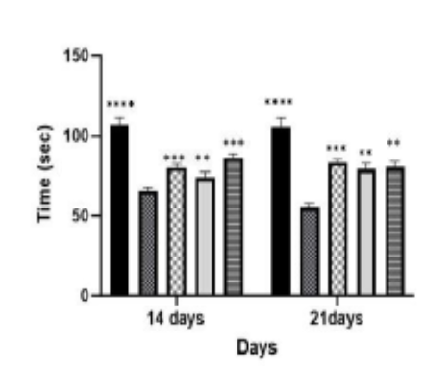


Indian Journal of Science and Technology
DOI: 10.17485/IJST/v16i48.3023
Year: 2023, Volume: 16, Issue: 48, Pages: 4710-4720
Original Article
B K Supriya1, N Prem Kumar2*, Pravash Gurung1, Barsha Bhujel1, Dikcha Gupta1, A Deekshitha1
1Student, Department of Pharmacology, Krupanidhi College of Pharmacy, Bengaluru, 560035, Karnataka, India
2Professor, Department of Pharmacology, Krupanidhi College of Pharmacy, Bengaluru, 560035, Karnataka, India
*Corresponding Author
Email: [email protected]
Received Date:27 November 2023, Accepted Date:24 December 2023, Published Date:30 December 2023
Objective: The aim of this study was to examine the effect of Operculina turpethum (Linn.) root extract in attenuating reserpine induced Parkinson’s disease to quench the free radicals produced as a result of the increased oxidative stress in Parkinson disease. Methods: Parkinson’s disease is induced by administration of reserpine (0.1 mg/kg/day, i.p.) in albino rats for 21 days. Simultaneously the rats were pretreated with two doses of hydroalcoholic extract of Operculina turpethum (200mg/kg and 400mg/kg p.o.) daily once for the 21 days. The anti-Parkinson’s effect of the extract was evaluated by assessing various behavioral (motor and non-motor) and biochemical (lipid peroxidation, creatinine, acetylcholine esterase and total protein) parameters as well as histological examination. Findings: Reserpine significantly causes tremor, rigidity, akinesia which were reversed by daily administration of Operculina turpethum root extract that may be attributed to a reduction in the acetylcholine, total protein, and creatine due to multifunctional activity of various phytochemicals present in the Operculina turpethum extract when compared to L-DOPA/C-DOPA group. There was a significant histological improvement in the neuronal degeneration in brain tissue on treatment with Operculina turpethum root extract. The results indicated the protective effect of Operculina turpethum extract against Parkinson’s disease. Novelty: Dopamine replacement and levodopa, two prevalent medications for PD, only exhibit some effects of limited symptomatic relief but cause many severe adverse effects, such as hallucination and involuntary movement. The hydroalcoholic extract of Operculina turpethum roots can be favourable for the development of disease-modifying drugs for Parkinson’s disease.
Keywords: Operculina turpethum; Parkinson’s Disease; Reserpine; Lewy bodies; Neuroprotective
© 2023 Supriya et al. This is an open-access article distributed under the terms of the Creative Commons Attribution License, which permits unrestricted use, distribution, and reproduction in any medium, provided the original author and source are credited. Published By Indian Society for Education and Environment (iSee)
Subscribe now for latest articles and news.